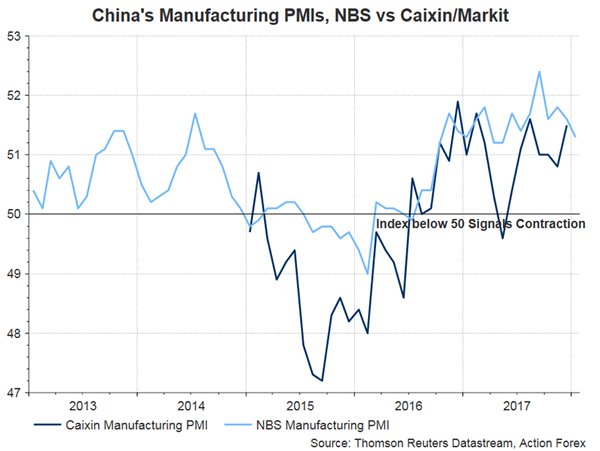China’s official manufacturing PMI slipped -0.3 point to 51.3 in January, compared consensus of 51.5, as almost all sub-indices dropped during the month. The non-manufacturing PMI added +0.3 point to 55.3, beating expectations of 55, in January. Note that the services sector contributes about 80% and construction sector contributes 20% to the index. The services PMI rose +1 point 54.4 while the construction PMI slipped -3.4 points to 60.5 during the month. Besides the abovementioned barometers, the government introduced the composite PMI output index which steadied at 54.6 in January. The index is calculated as the weighted average of the headline non-manufacturing PMI and the output sub-index of the manufacturing PMI. The government indicated that the composite PMI is a more comprehensive indicator for overall economic growth in China. Overall, the December report revealed deceleration in the country’s growth in the manufacturing activities. This was, however, offset by the stronger growth in the services sector.

In the manufacturing sector, both ‘production’ and ‘new order sub-indices dropped this month, falling -0.5 point to 53.5 and -0.8 point to 54, respectively. The employment sub-index slipped – 0.2 point to 48.3. Meanwhile, both input and output price sub- indices dropped in January. While the former fell to 59.7 from 62.2, the latter was down to 54.4 from 51.8 this month. This might imply further slowdown in inflation as the 2018 begins. Meanwhile, trade-related indicators softened, with new export orders drifting to the contractionary territory (at 49.5) in January, from 51.9 in December, and imports falling to 50.4 from 51.2 in December.
On the non-manufacturing sector, including services and construction activities, new orders sub-index slid -0.1 point to 51.9. Meanwhile, the input prices sub-index fell -0.9 point to 53.9 while the sales price sub-index stayed unchanged 52.6. The employment sub-index climbed +0.1 point higher to 49.4. While staying in the contractionary territory, the situation has improved. Meanwhile, the decline was mainly driven by the construction sector.
The manufacturing PMI is often interpreted as a leading indicator of China’s IP growth data. Recall that in December, IP growth expanded +6.2% y/y, up from November’s +6.1%. Concerning individual industries, steel products, ferrous metal, and electricity production improved from the same period last year, but crude oil manufacturing and automobile manufacturing growth decelerated. Since the manufacturing PMI surprised to the downside in January, we would not be surprised of IP growth in January slowed. For the year ahead, we see domestic demand growth to moderate as the government continues to adopt targeted monetary tightening measures to curb excessive expansion of certain industries. Meanwhile, a relative strong renminbi might soften exports growth.













